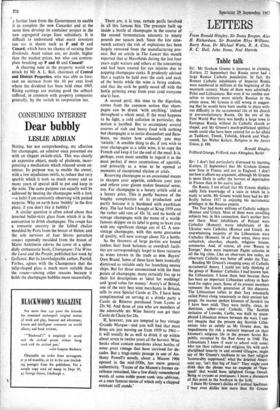Dear bubbly
CONSUMING INTEREST LESLIE ADRIAN
Noting, but not comprehending, my affection for champagne, an admirer once presented me with an elegant swizzle-stick. This was clearly an expensive object, made of platinum, incor- porating a mechanism which released seven an- tennae. Its purpose was to enable the owner, with a few injudicious twirls, to reduce that very sparkle which it took so much money and so many years of special skill to put and keep in the wine. The same purpose can equally well be achieved by beating the champagne with a fork —a habit I am constantly observing with pained surprise. Why on earth have 'bubbly' in the first place, if you don't like it bubbly? A similar question is often asked about that inverted ballet-skirt glass from which it is the convention to drink champagne. The coupe has a romantic ancestry in the fabled chalice moulded by Paris from the breast of Helen; and the sole survivor of four Sevres porcelain coupes reputedly moulded from the breast of Marie Antoinette adorns the cover of a splen- didly enthusiastic book, Champagne: The Wine, the Land and the People, published last week by Gollancz. But its knowledgeable author, Patrick Forbes, agrees with the Champenois that the tulip-shaped glass is much more suitable than the coupe—among other reasons because it holds the champagne bubbles more successfully. There are, it is true, certain perils involved in all this famous fizz. The pressure built up inside a bottle of champagne in the course of the second fermentation amounts to ninety pounds per square inch. Since the late nine- teenth century the risk of explosions has been largely removed from the manufacturing pro- cess. But an article in The Lancet this month reported that at Moorfields during the last four years eight waiters and others at the consuming end had been treated for eye injuries due to popping champagne corks. It prudently advised that a napkin be held over the cork and neck of the bottle while the wine is being undone, and that the cork be gently eased off with the bottle pointing away from your (and everyone else's) face.
A second peril, this time to the digestion, comes from the common notion that cham- pagne can be drunk 'with anything,' indeed throughout a whole meal. If the meal happens to be light, a cold collation in particular, the notion is justified. But to accompany several courses of rich and heavy food with nothing but champagne is to invite discomfort and flatu- lence, no matter how arduously you may 'swizzle.' A sensible thing to do, if you wish to treat champagne as a table wine, is to copy the French and keep it for the end of the meal. It is, perhaps, even more sensible to regard it as the most perfect if most ostentatious of aperitifs, and primarily as a wine to be opened at moments of exceptional elation or crisis.
Reserving champagne as an occasional means to sharpen your appetite, celebrate your joys and relieve your gloom makes financial sense, too. For champagne is a luxury article sold at a luxury price. This is partly because of the lengthy complexities of its production and partly because it is burdened with exorbitant duty. The last bottle I bought of Krug 1959 cost the rather odd sum of 43s 7d, and no bottle of vintage champagne with the name of a world- famous shipper on its label is going to leave you with any significant change out of £2. A non- vintage champagne, with this same guarantee of quality, will now average about 32s a bottle.
So the throwers of large parties are bound (unless their bank balances or overdraft facili- ties are correspondingly large) to have recourse to wines known in the trade as BOB, Buyers' Own Brand. Some of these have been ironically dismissed as suitable only for launching enemy ships. But for those unconcerned with the finer points of champagne, many certainly live up to their list descriptions as 'ideal for weddings' and 'good value for money.' Avery's of Bristol, one of the very best wine merchants in Britain, sells its own Special Cuvee at 25s. I have been complimented on serving at a drinks party a Cuvee de Reserve purchased from Lyons at 23s 9d. And those of you who are members of the admirable IEC Wine Society can get their Cuvee de Choix for 24s.
If, however, you are tempted to buy vintage Grande Marque—and you will find that most firms are just moving on from 1959 to 1961— it will usually be as well to drink it up within about seven to twelve years of the harvest. Wine books often contain anecdotes about bottles of some great vintage that have survived for de- cades. But a tragi-comic passage in one of An- thony Powell's novels, about a Mumm 1906 opened in the mid-1930s, has more general authenticity. 'Traces of the Mumm's former ex- cellence remained, like a few dimly remembered words of some noble poem sunk into oblivion, or a once famous statue of which only a chipped remnant still stands.'






































 Previous page
Previous page